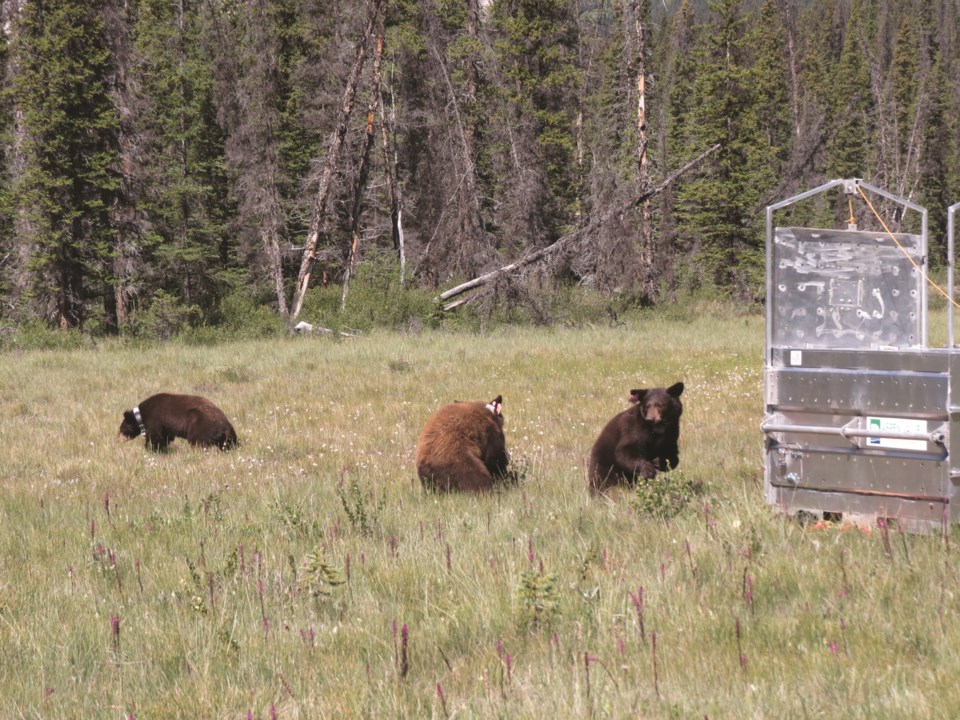BANFF – Two of the three orphaned black bear cubs found in a public washroom near Vermilion Lakes in 2017 have slipped out of their tracking collars, according to officials with Parks Canada.
The bruins emerged from their den this spring and are believed to be living in Banff National Park, though no sightings of the bears have been made by Parks.
"As far as we know, those two animals are out there on the landscape being bears," said wildlife coexistant specialist, Blair Fyten.
After the bears' first winter in rehabilitation facility, the bears were reintroduced to the Bow Valley last year with tracking collars and ear tags.
The collars of the two surviving bears stopped moving earlier this spring, but Fyten said the bears are tagged and there's no indication that they've died or been killed.
"It took us a little while to get somebody out in the field to investigate this because the water was high and where they had to get to was a little inconvenient at the time," he said. "We did get staff out to both of these locations and we located both of the collars. At both of the sites, we never found any indication of predation or anything, no dead animals, and looking at the collars they were all intact."
Fyten said this means the collars slipped off, further explaining the bears likely lost some weight while learning how to survive in the wild.
"These collars were slipped off and potentially the reason being is when these animals came back from the rehab centre, they are quite a bit heavier and fatter than bears in a wild and it takes them a little while to figure out how to find their food, where it's at, things like that," he said. "Also with denning, bears lose weight during the winter time.
"We believe these bears were able to slip the collars over their heads."
The collars have a mechanism that means they would have fallen off in the late summer, or early fall anyway, to accomodate the growth of the bears, according to Fyten.
While two of the bears successfully denned in the winter within the park and have since emerged from their dens, the third bear was found dead only a month after their initial release last year.
"We released them in the back country last year on July 17, 2018," said Fyten. "It was a month later or so we lost one of them due to predation, another large carnivore, potentially a grizzly bear, had killed it.
"But the other two remained on the landscape through the rest of the year and they successfully denned relatively close to where we released them."
Fyten said the two surviving bears denned roughly six to seven kilometres away from one another. The one that was killed, on the other hand, ventured further away from the other two after it was released.
"What was different about that bear was it ranged quite far and wide, it seemed to be on a mission trying to figure out where it was," he said. "It travelled a fairly large area compared to the other two, so that just kind of puts it more at risk, it's more exposed to predation – chances of running into a grizzly bear, things like that."
Fyten said with reintroduction there are two key elements to keep in mind: habitat and exposure to humans.
"You need to have a spot to put these bears where there's adequate, high quality habitat, so good bear food," he said. "Another important thing is that they have minimum contact with humans for seven to 10 days post release, just so they can figure out that they're supposed to be a bear."
The three black bear cubs were found inside a public washroom on the side of the Trans-Canada Highway near Vermilion Lakes two years ago and despite a three-day extensive search, their mother could not be located. The bears were then transfered to Ontario where they spent 15 months at the Aspen Valley Wildlife Sanctuary. In an interview last year, Bill Hunt, a resource conservation officer with Parks Canada, told the Outlook they suspect the cubs were left by someone.
"We don't have any additional information and it's impossible to speculate how they got in there," said Hunt. "We certainly believe they had some help from person or persons."
The cubs were rehabilitated in Ontario and then brought back to Banff National Park last July. While the loss of one of the three female bruins is disappointing, Fyten said the reintroduction is still considered a success as the survival rate for young orphaned bears isn't as high as cubs who still have their mothers to rely on.
"We look ast this as being a success. We sent these three bears to a rehab centre and brought them back, put them back on the landscape even though there's a chance they didn't even come from the park ... as far as we know two out of the three are still surviving and for us, that's quite a success."
– With files from Paul Clarke




